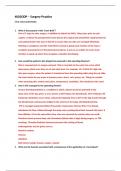4003ODP – Surgery Practice
VIVA VOCE QUESTIONS:
1. What is the purpose of the ‘Team Brief’?
Part of 5 steps to safer surgery, in addition to debrief by WHO. Takes place prior to each
surgery. It allows the perioperative team discuss the surgical and anaesthetic requirements for
each patient before the start of the list to ensure that any risks are managed effectively.
Working in compliance and the Team Brief is aimed at giving each member of the team a
complete shared picture of the planned procedures, it acts as an enabler for every team
member to speak up when they recognise a situation developing.
2. How would the patient’s skin integrity be assessed in the operating theatres?
Skin is assessed prior to surgery and post. This is recorded via the water low score which
determines which score they are at and what level. For example, 10= At Risk 20= High risk.
Also post-surgery, when the patient is transferred from the operating table using the pat slide,
the team checks for any areas of pressure sores, ulcers, cuts, grazes, etc. Things to consider
when assessing skin, texture and colour, temperature, sensitivity. Also checked on the ward.
3. How is VTE managed in the operating theatre?
Venous thromboembolism is a condition in which a blood clot forms primarily in the
deep veins of the leg, groin, or arm, known as DVT (deep vein thrombosis). DVT is linked to PE
Pulmonary Embolism occurs when a blood clot (typically from a DVT in the leg) travels through
the bloodstream and becomes lodged in the arteries in the lungs, blocking blood flow.
VTE is managed using Intermittent Pneumatic Compression Devices (Flow Tron Boots).
stimulates the flow of blood through the deep veins, pushing blood back towards the heart. It
then deflates. It has the same effect how veins are squeezed by muscles when you walk.
Flowtrons boots prevent deep vein thrombosis (blood clots in legs) during surgery. or TED
stockings, Thrombo-Embolus Deterrent-prevents the clotting of blood.
Anticoagulants may be given such as:
Warfarin sodium
Clexane
Apixaban
Risk factors include trauma, surgery, obesity
4. What are the hazards associated with, and purpose of the application of a tourniquet?
, Hazards: Local soft tissue damage: burns (occlusive drape is used around the tourniquet),
fitting is too tight or too loose. Necrosis (tissue death) and tourniquet pain.
After 2 hours if the surgery is still not complete tourniquet must be deflated & limb
reperfused for a minimum of 15 minutes before tourniquet is reinflated.
Purpose: A limb tourniquet with a timer alarm should be used.
Used to control bleeding, creating bloodless field to improve surgical visibility.
Bier's Block is the application of regional anaesthesia and is used to exsanguinate (drain blood)
the limb using a double tourniquet to isolate it from circulation. (Rarely used anymore, but
please mention as this is a competency in the PAD).
Upper limb – 200-250mmhg millimetre mercury. Lower limb – 300-350mmhg. Depending on
patient BMI, higher pressure would be used.
Application: Ensure patients skin is dry, choose correct shape and size, ensure selected
tourniquet has O-ring present (O-rings create a seal &
without one the tourniquet will not hold the right pressure). Protection applied to patient’s
skin, should cover the entire circumference of limb, and extend past borders of tourniquet.
The ends of the tourniquet bladder should overlap by 7-15cm. Consideration should be given
to ensure tourniquet is not too tight or too loose on limb (2 finger breaths underneath the
tourniquet will suffice). To prevent potential skin burns from skin preparation solution ensure
an occlusive drape is used around the tourniquet. Only deflate when the surgeon says it is
appropriate to do so.
5. What is the purpose of diathermy? (Student should define what diathermy is too and the
differences between monopolar and bipolar). High frequency alternating current which passes
through the body, helps to make precise incisions, minimizing/reduces blood loss, prevents
excessive bleeding by sealing off traumatized tissues or cauterizing blood vessels. Diathermy
produces variety of electrical waveforms/settings Cut and Coag.Cut, cuts through tissue cells,
generating heat.
Cut uses low voltage electric current waveform which vaporises the tissues on contact.
Coag uses a higher voltage, and instead of tissue vaporization, a coagulation effect is
produced-blood changes from liquid to gel, potentially resulting in hemostasis.
Monopolar is where an active electrode is held by surgeon, creates a heating effect and the
current oscillates between surgeons electrode through patient’s body until it reaches the
diathermy on the patients surgical site, back buttocks thigh stomach.
Bipolar: 2 active electrodes which is performed by a pair of forceps for sealing blood vessels.




